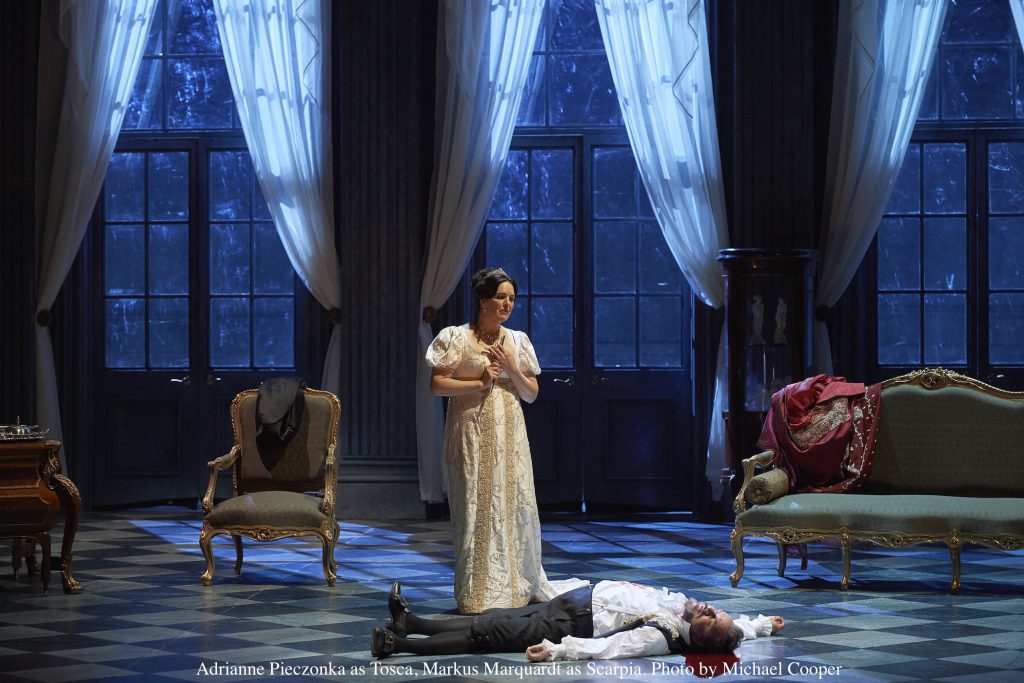Tosca by Giacomo Puccini, libretto by Luigi Illica and Giuseppe Giacosa from the play, La Tosca, by Victorien Sardou. A sizzling chronicle of passion and betrayal set in Rome, 1800, featuring Tosca, singer, celebrity, lover of the painter Cavaradossi, a suspected enemy of the state whom she schemes to rescue from torture and execution at the hands of Baron Scarpia, sadistic chief of police. Also appearing in a contributing offstage role, Napoleon Bonaparte.
Arguably the supreme expression of late 19th century post Romanticism, Puccini’s gripping period shocker is a model of extended reality, magnified and made intense. Mindful of their Italian audience’s collective historical consciousness, composer and authors leap from overture to mid-action, avoiding considerable intervening exposition.
In February, 1798, the Emperor Napoleon’s troops marched into the Papal States, expelling the presiding Austrian-supported Pope and proclaimed the Roman Republic, launching a Continental campaign for revolutionary regime change. Italian patriots were overjoyed. The Hapsburgs and their retinue of privileged enablers had long ruled with a heavy hand. No sooner had the liberal-minded Bonaparte departed to set sail for Egypt, than Austrian-backed forces retook control of the Eternal City, sweeping up the likes of the former French-appointed consul — Cesare Angelotti in Puccini’s operatic account — in a vicious, reactionary purge. Tosca’s breathless drama mirrors the ensuing events to gripping effect.
The monumental Te Deum that closes Act I, not without a certain measure of subtextual censure and irony, celebrates the restoration of martial law and order in the wake of Napoleon’s apparent defeat on his fateful return to the Italian peninsula. Tosca, never one to ignore a career opportunity, entertains a select gathering of relieved royalists with an airy cantata at the Palazzo Farnese. But the tide of factual history was not to be so easily turned aside. Illica and Giacosa reflect the moment when destiny prevails.
The French army regrouped and counter attacked. The occupying Austrians were crushed. A message reaches Scarpia. Bonaparte è vincitor! The story plunges forward to its violent conclusion.
Tosca writes its own ending to history’s stormy tale.
Reprising its striking offering of 2008, presented again in 2012, the Canadian Opera Company in conjunction with Norwegian Opera and Ballet mounts a potent production of one of opera’s greatest masterpieces with a muscular, big-boned, superbly accomplished iteration. Old World style meets New World energy.
The clash of fractious ideologies, raised to the level of high art, ignites more than a little combustible drama in Puccini’s blistering chronicle. Tosca’s protagonists are unabashedly idealistic. Cavaradossi and Angelotti, liberal humanists to the core, embody the high-minded ideals of the French Revolution struggling to be heard in increasingly repressive 18th century Italy — Libertà! Eguaglianza! Fraternità! Tosca, decidedly apolitical, zealously pious, professes simple, absolute love for the Madonna in the face of state-organized corruption and profanity. She, too, comes to champion freedom. All will die for their beliefs.
But Puccini is no dogmatist and Tosca, no antique political/religious parable. Love and sex in all their messy permutations impel everything and everyone, including the reptilian Scarpia in his cold-blooded persecution of his radical opponents. Lust and lechery is his true mania, sadism made sexual.
Autocracy, Puccini seems to say, is to be resisted whatever the cost, prodigiously paid for in blood in Tosca. Human dignity and independence flows, as the composer would surely insist, not so much as a consequence of absolute evil defeated but from the soul unchained. Written a full 100 years after the fictional action has transpired, Puccini’s blockbuster thriller carries with it something of a dark, existential sensibility.
Director Paul Curran, designer Kevin Knight, lighting director David Martin Jacques, all do fine work extracting taut, plausible reality from what is in essence a melodrama, albeit a compelling one. Expectations are skilfully manipulated. The austere gloom of the Church of Sant’Andrea della Valle dissolves into dazzling liturgical spectacle. All the sophistication and refinement of the Palazzo Farnese cannot mask the screams echoing from Scarpia’s hidden torture chamber. The Castel Sant’Angelo rises like some evil ruin, shadowy and brooding. All is revealed. Time is made liquid. Nothing can halt its ghastly advance.
Huge sets. Grand emotions. Boundless expression. Tosca is a monument to Puccini’s searing artistic vision. Singing, as in so much of the composer’s other work, is informed by suffering, occasionally external to character, more typically, stemming from within. There is scarcely a single aria, arioso or line of accompanied recitative in Tosca that does not derive from pain. Beauty — of which admittedly there is a good deal here — is voiced, not freely, but rather in moments of intervening repose. Dissonant storm clouds gather, break, then recede, only to quickly rebuild in fury. Interior vocal monologues are exceptional, principal duets more the norm, both scaling down the enormity of the theatrics to intimate, more manageable scale.
Visiting conductor Keri-Lynn Wilson leads the magnificent Canadian Opera Company Orchestra in an impassioned reading of Puccini’s tempestuous score, vibrant, resonant, rich in detail. Tone painting is gorgeous, particularly evident in the celebrated opening of Act III, a panorama of shifting colour and glowing harmony as Cavaradossi’s execution day dawns, gently, peacefully, acutely tearfully. Leitmotifs, never quite fully developed by the composer, are powerfully stated nevertheless. The ominous triple chords of Scarpia’s theme are as spine-tingling as they are ubiquitous.
Despite the presence of several of opera’s most cherished arias, Tosca is not primarily a numbers piece. Music surges through it like a river, bearing the action relentlessly forward. Wilson and players unleash its full force.
Appearing in the title role, soprano Adrianne Pieczonka invests her Tosca with all the pre-requisite passion the role demands coupled with a mellow maturity and wordliness that adds a profound depth of humanity to her performance. The strength and power of this voice is made all the more remarkable by the sheer beauty of her shimmering articulation. Channeling her seemingly infinite lyricism, Pieczonka delivers Puccini’s poignant plea for heavenly intercession, Vissi d’arte (“I have lived for art”) with moving sensitivity.
Singing Cavaradossi, Argentine tenor Marcelo Puente mesmerizes with his heartrending rendition of the exquisitely celestial aria E lucevan le stelle (“And the stars would be shining”) slipping effortlessly into its gorgeous companion piece O dolce mani (“Oh, sweet hands”). His is a glorious instrument, golden and gleaming, bright and soaring in its upper reach, honeyed in mid to lower ranges. Here is a singer actor of truly romantic proportions, spirited and raffish on stage endowed with great charisma, ever in the present.
Dusseldorf native Markus Marquardt is Scarpia, his somewhat angular bass-baritone infused with all the venom and menace of the detestable Baron. To act with the voice is a challenging proposition for any principal in any opera anywhere. Marquardt is a master practitioner. Tosca, mi fai dimenticare Iddio! (“Tosca, you make me forget God!”), he rages. This steely, tightly wound Scarpia is utterly to be believed.
Donato Di Stefano is a bustling, sharp-tongued Sacristan, splendidly sanctimonious. South African-born Musa Ngqungwana is Angelotti, a haunted, hunted man at the end of his wits. Joel Sorensen as Spoleto and Giles Tomkins as Sciarrone, Scarpia’s ruthless henchman, radiate brutality. Bruno Roy is a grasping jailer.
Featured in a fleeting comprimario role as a young shepherd boy, 15-year old Clara Moir gifts us with Puccini’s wispy alto air, Io de’ sospiri (“I send you as many sighs”), the inexpressibly sad little folk tune that precedes the horror of Act III.
Children and choir boys cast from the Canadian Children’s Opera Company delightfully partner the men and women of the Canadian Opera Company Chorus, filling the vastness of Act I with prayer as the congregation and clerics of Sant’Andrea della Valle.
Amid all the towering works of classical musical theatre, Tosca stands tall. Virtually every wide-eyed opera-goer, veteran and newcomer alike, cradles Puccini’s timeless tragedy close to their heart. With this forceful, endlessly engaging production, the Canadian Opera Company awakens the magic for all of us, conjuring lasting new memories.


